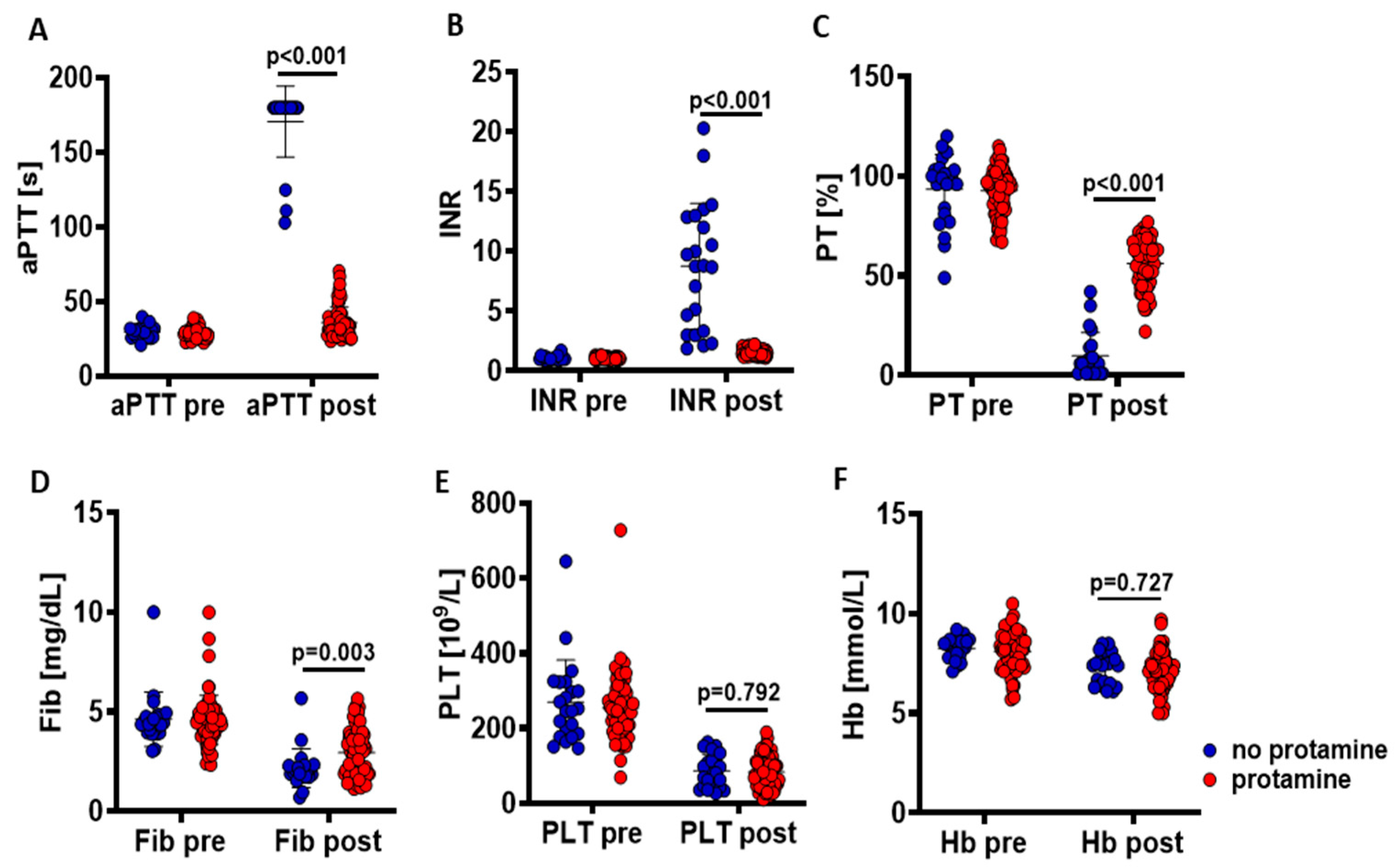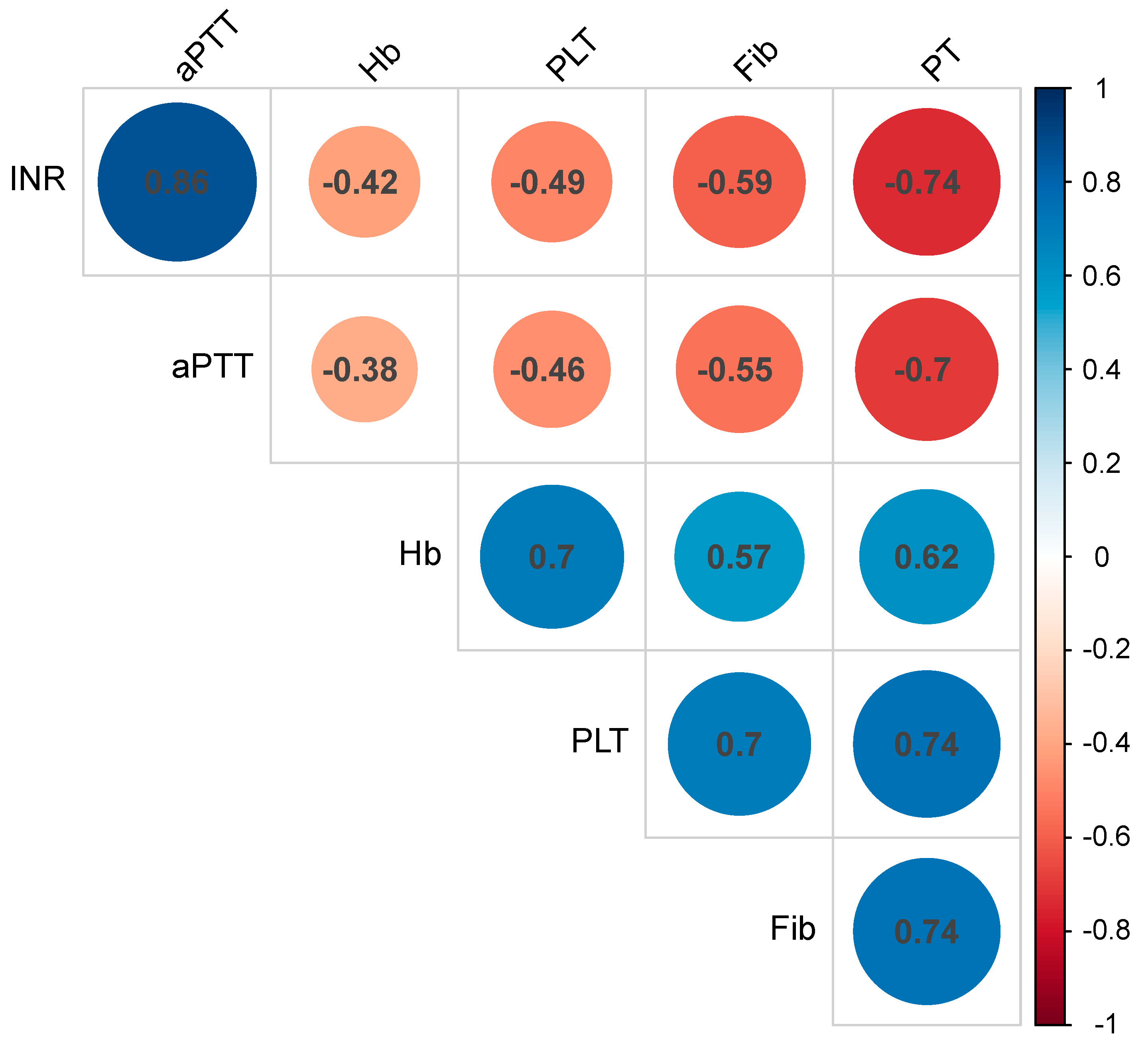The present results confirm previous reports that percutaneous hepatic chemosaturation, including high-dose heparin administration, extracorporeal circulation, and chemofilter application, significantly increases aPTT and INR and decreases PT, fibrinogen, PLT, and Hb levels [
1,
2,
3,
4,
5,
6,
8]. The novel findings are that heparin reversal with protamine not only normalizes aPTT but also restores the INR, PT, and fibrinogen levels, which are effects that remained stable for the INR and PT after adjustment for aPTT. Furthermore, a dose-dependent association between the aPTT and fibrinogen level was observed for protamine.
4.1. Characteristics of Heparin Effects
The effect of heparin on PT may be the result of the binding of heparin to antithrombin, which causes a conformational change that leads to its activation. Antithrombin then exerts its inactivating effects primarily on thrombin and factor Xa. Since thrombin (which is involved in the common coagulation pathway of the coagulation cascade) is inhibited, it prolongs PT. However, two measures are responsible for allowing the measurement of PT in the presence of therapeutic heparin: first, the dilution factor, and second, heparin neutralizers (e.g., heparinase), which are used in most commercial PT assays [
20]. Since heparin in blood samples influences the performance of PT reagents, PT reagents may compensate for 1–2 U/mL of heparin, whereas excess dosages ultimately still lead to prolonged PT and INR [
21,
22]. The different sensitivities of PT measurements when using different reagent charges may also influence the interpretation of the results. The high dependency of the results on different commercial assays was the historical reason for the development of the INR to improve comparability [
23].
Fibrinogen levels after hepatic chemosaturation without heparin reversal with protamine levels were significantly lower than those with protamine (
Figure 1D), which would be presumably affected by high doses of heparin in the measurement of fibrinogen, as reported in the cardio-pulmonary bypass [
19]. Those pseudo-low levels of fibrin during measurement probably reflect the results of
Table 2,
Table 3,
Table 4,
Table 5,
Table 6 and
Table 7.
4.2. Characteristics of Protamine Effects
Heparin reversal with protamine is considered mandatory in percutaneous hepatic chemosaturation procedures [
7]. The normalization of coagulation parameters, usually observed within 24 h after the procedure, is important before the removal of the vascular sheaths. Prolonged coagulopathy can lead to severe bleeding complications, which may include airway compromise, stridor, and impaired laryngoscopy visibility if emergency tracheal intubation is required [
6]. This may be particularly true after the removal of the large bore sheath and central venous catheter from the internal jugular vein. In addition, angiographic bleeding control or open surgical repair has been reported in the postoperative period following hepatic chemosaturation. However, few studies have specifically analyzed postoperative coagulation management in chemosaturation patients with or without protamine administration [
9,
18]. After one center abandoned postinterventional protamine reversal due to severe thromboembolic complications (two cases of cerebral ischemia in 141 procedures in 60 patients), our center also decided to use protamine in a more individualized approach and case-by-case decision [
8]. However, we changed our standards back to the mandatory use of protamine after experiencing several severe bleeding complications. Another recent two-center study involving 256 procedures in 116 patients (including the data sets of the previously cited study from Hannover, Germany, and another center from Hamburg, Germany) suggested that the standard use of protamine after chemosaturation in low-risk patients without clinical signs of active bleeding should be critically re-evaluated [
9]. In this population, ten thromboembolic events (seven ischemic strokes and one each of myocardial infarction, deep vein thrombosis, and pulmonary embolism) were found in 192 cases of 92 patients who received full protamine reversal (1:1 ratio), compared with no thromboembolic events in the reduced protamine reversal (21 cases of 13 patients) and no-reversal (43 cases of 28 patients) groups. Regarding bleeding complications, 24 events were observed in the full reversal group, two in the reduced reversal group, and 12 in the no-reversal group. ACT rates were significantly higher in the no reversal group at the last measurement after chemosaturation. Interestingly, the highest rate of thrombocytopenia was observed in the full reversal group (39%) compared to reduced and no reversal (14% and 23%, respectively). However, thrombocytopenia was only classified as binary, and a platelet count was not presented, and details on other coagulation parameters (INR, PT, aPTT, and fibrinogen) were not presented. In addition, one case of severe anaphylactic shock was observed after protamine administration. In the current data set, an independent protective effect of protamine against postoperative bleeding complications was observed, while thromboembolic events were not observed, presumably due to the high proportion of cases receiving protamine-to-heparin ratios of less than 1:1 [
18].
The overall efficacy of protamine reversal has been extensively studied. In a recent randomized controlled trial of patients undergoing transfemoral transcatheter aortic valve implantation, the routine administration of protamine resulted in a reduction in minor vascular complications, procedure time, and post-procedural hospital stay compared to patients receiving a placebo [
24]. The safety profile of protamine in study cohorts of different interventions suggests that the rate of adverse events (e.g., hypersensitivity reaction, stent thrombosis, myocardial infarction, pulmonary embolism, and stroke) is low [
25,
26,
27]. Therefore, a reduced dose regime of protamine might be a promising strategy to reduce or avoid adverse events. This finding is supported by recent studies in cardiac surgery patients showing that reducing the protamine dose did not significantly increase blood loss [
25,
28]. Clinical concerns include the possibility of protamine overdose and subsequent paradoxical bleeding [
10,
11]. Protamine may reduce both platelet count and platelet function, probably by impairing the interaction of glycoprotein iB with the von Willebrand factor [
29]. Therefore, the complex interactions of heparin and protamine have a relevant influence on clinical decisions [
30,
31].
Determining an optimal protamine-to-heparin ratio for all patients poses methodological challenges. First, heparin response varies widely among patients due to differences in body weight, age, renal function, and individual sensitivity, which complicates the determination of a universal protamine-to-heparin ratio that is effective for all patients [
32]. Secondly, conventional assays, such as activated partial thromboplastin time (aPTT), lack the requisite sensitivity to accurately reflect heparin concentration due to their inherent variability. On the other hand, more specifically, anti-factor Xa assays are neither always available nor validated for protamine adjustments [
33]. Thirdly, protamine may lead to impaired clot formation and inhibit thrombin formation if over-administered when given in ratios exceeding 1:1 [
32]. Finally, protamine and heparin differ in their pharmacokinetic profiles. While protamine demonstrates rapid action and a brief duration of action, heparin can exhibit prolonged activity. The future may entail the implementation of thrombin generation assays; however, these are not yet part of standard clinical practice.
The present findings suggest that the normalization of the INR, PT, and fibrinogen should be confirmed after hepatic chemosaturation even when immediate postinterventional ACT and aPTT measurements reveal normal values. Furthermore, vascular sheaths should remain in place until approximately 12 h after the intervention, and the puncture sites should be monitored closely to avoid bleeding complications.
In general, protamine should be infused slowly and with extreme caution. Its potential to cause severe anaphylactic reactions, including shock and cardiac arrest, is based on the release of histamine from tissue mast cells within the blood vessels. Emergency treatment includes the rapid infusion of large volumes of crystalloid and vasopressors (epinephrine) [
34]. An individual predisposition to allergic reactions to protamine can be screened during the initial selection of patients.











